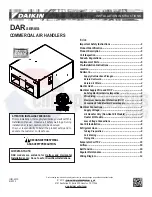
035-000049-001
Page 21
HCA IOM 1.1 8-28-2017
2. Drain coil as described in procedures for Anti-
freeze Methods of Coil Protection.
3. Connect air supply or air blower to inlet header
connection and close its drain connection.
4. Circulate air and check for air dryness by hold-
ing mirror in front of open vent in outlet header
drain connection. Mirror will fog if water is still
present.
5. Allow coil to stand for a few minutes; repeat
Step 4 until coil is dry.
PIPING — Direct expansion, chilled water, and hot
water coils should always be piped for counterflow.
(Fluid should enter the coil at the leaving-air side.)
Steam coils must have the condensate connection
at bottom of coil.
To determine intervals for cleaning coils in contami-
nated air operations, pressure taps should be in-
stalled across the coils and checked periodically.
Abnormal air pressure drop will indicate a need for
cleaning the coils.
Steam Systems
Annual steam system maintenance should include:
1. Clean the line strainers.
2. Blow down the dirt leg.
3. Clean and check operation of steam traps.
4. Check operation of control valves.
5. Check the operation of check valves to prevent
condensate flowback.
6. Check operation of thermostatic air vents, if
used. A float and thermostatic trap will contain
a thermostatic air vent. When the bellows is
ruptured, it will fail closed.
7. Check operation of vacuum breakers.
8. Check operation of the thermal protection devic-
es used for freeze-up protection.
9. Steam or condensate should not be allowed to
remain in the coil during the off season. This will
prevent the formation and build up of acids.
There are additional precautions and control strate-
gies, as found in various catalogues and in the
ASHRAE Fundamentals Handbook when the enter-
ing-air temperature to the coil falls below 35 F.
These conditions occur when IDT coils are used for
pre-heat and/or face and bypass applications.
Freeze up protection:
1. Use a strainer in the supply line and the dirt leg
ahead of the trap.
2. Use a vacuum breaker in the return.
3. Do not use overhead returns from the coil. A
floodback can occur.
4. An immersion thermostat to control outdoor-air
dampers and the fan motor is recommended. This
control is activated when the steam supply fails or
the condensate temperature drops below a prede-
termined temperature, usually 120 F.
5. On low pressure and vacuum systems, the im-
mersion thermostat may be replaced by a conden-
sate drain with a thermal element. This element
opens and drains the coil when the condensate
SERVICE—Fan Motor Replacement (cont’d)
temperature drops below 165 F. Note the ther-
mal condensate drain is limited to 5 psig pres-
sure. At greater coil pressures they will not
open.
In spite of the precautions listed above, a coil
may still freeze up. An oversize capacity coil, at
partial load, with a modulating steam control
valve will occasionally freeze. Freezing occurs
in the 20 F to 35 F range of entering-air tem-
peratures. A better installation would be an un-
dersize coil, with an on/off control valve with
thermostatic control in the outside air, set at 35
F air temperature, installed downstream of the
first coil; or setting the minimum steam pres-
sure at 5 psig.
Filters
FILTER SECTIONS — Open or remove filter
panel to replace old filter with a new filter. See
physical data tables for filter data.
Summary of Contents for HCA 04
Page 2: ...035 000049 001 Page 2 HCA IOM 1 1 8 28 2017 THIS PAGE INTENTIONALLY LEFT BLANK...
Page 26: ...035 000049 001 Page 26 HCA IOM 1 1 8 28 2017...
Page 28: ...035 000049 001 Page 28 HCA IOM 1 1 8 28 2017 THIS PAGE INTENTIONALLY LEFT BLANK...
Page 29: ...035 000049 001 Page 29 HCA IOM 1 1 8 28 2017 THIS PAGE INTENTIONALLY LEFT BLANK...






























